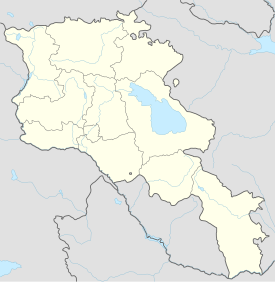Yervandashat or Eruandashat (Armenian: Երվանդաշատ (reformed); Երուանդաշատ (classical))[a] was an Armenian city and one of the historical capitals of Armenia, serving as the capital city between c. 200 BC and 176 BC under the rule of the Orontid dynasty and at the beginning of the rule of their successors, the Artaxiad dynasty. Its ruins are located on a rocky hill near the confluence of the Akhuryan and Aras rivers, on the left bank of the Aras, between the villages of Yervandashat and Bagaran in modern-day Armenia.
Երուանդաշատ | |
 | |
| History | |
|---|---|
| Builder | King Orontes IV of Armenia |
| Founded | c. 200 BC |
| Abandoned | After the 7th century AD |
Etymology
editEruandashat, which translates as "Joy of Ervand (i.e., Orontes)",[1] is the Armenian form of the toponym and derives from Middle Persian *Arwandašād (compare Old Persian *Aruvanta-šiyāti-).[2]
History
editYervandashat was built around 200 BC[1] by the last Orontid king of Armenia, Orontes (Eruand) IV.[1][3] It was located on a rocky height on the left bank of Aras River,[4] near the confluence of the Akhuryan and the Aras, in the historical Arsharunik canton of the Ayrarat province of Armenia Major.[1] Its ruins are located between the villages of Yervandashat (former Bakhchalar) and Bagaran (former Kheribeklu) in modern-day Armenia.[1]
According to Movses Khorenatsi, Orontes founded Yervandashat to replace Armavir as his capital after Armavir had been left dry by a shift of the course of the Aras. However, historian Babken Arakelyan believes that the real reason for the move was that Orontes' rival Artaxias had taken over Armavir.[4] It remained the capital until Artaxias I (r. c. 189 – 161 BC) founded the new capital of Artashat (Artaxata) around 176 BC. According to Khorenatsi, Yervandashat was renamed Marmet or Artamet for a short time.[1] Yervandashat was well fortified with ramparts and a citadel and had some importance as a commercial center.[1] It was populated by Armenians and other groups that had been resettled there during the reign of Tigranes the Great (r. 95–55 BC).[4] It had a large Jewish population.[1]
In the 4th century AD, King Tiridates III the Great (r. c. 298 – 330) granted the city to the house of Kamsarakan. Thus, Yervandashat became the center of the district of Arsharunik.[1] The city was destroyed by the army of the Sasanian king Shapur II in the 360s AD[4] and its population was deported to Persia.[1] Yervandashat still existed in the 7th century, but it never regained its former significance.[1] The remains of walls, streets, and buildings of the ancient city have survived, as well as the ruins of a settlement built on the site during medieval times, two ruined churches, khachkars and mural inscriptions.[4]
The archaeological site has not been the subject of major excavation, but some preliminary examination of the fortifications has been done and some remains of palaces have been uncovered.[citation needed]
Notes
edit- ^ Yervandashat reflects the modern Armenian pronunciation, while Eruandashat is a romanization from Classical Armenian.
References
editCitations
edit- ^ a b c d e f g h i j k Hewsen 1998.
- ^ Canepa 2018, p. 99.
- ^ Toumanoff 1963, p. 75 n. 83: "The capitals of Armenia were successively: Armavira or Armawir of the Orontids (Manandyan, O torgovle 37) until the transfer by Orontes IV of his residence to Eruandašat (*Orontasata)".
- ^ a b c d e Arakelyan 1977, p. 640.
Bibliography
edit- Arakelyan, B. (1977). "Ervandashat". In Simonyan, Abel (ed.). Haykakan sovetakan hanragitaran [Armenian Soviet Encyclopedia] (in Armenian). Vol. 3. Yerevan. pp. 639–640.
{{cite book}}: CS1 maint: location missing publisher (link) - Canepa, Matthew (2018). The Iranian Expanse: Transforming Royal Identity Through Architecture, Landscape, and the Built Environment, 550 BCE–642 CE. Oakland: University of California Press. ISBN 9780520379206.
- Hewsen, Robert H. (1998). "Eruandašat". In Yarshater, Ehsan (ed.). Encyclopædia Iranica, Online Edition. Encyclopædia Iranica Foundation. Retrieved 30 November 2023.
- Toumanoff, Cyril (1963). Studies in Christian Caucasian History. Georgetown University Press. OCLC 505712128.
Further reading
edit- Arakelyan, B. N. (1965). "Ortegh en gtnvel Ervandashat ev Ervandakert kʻaghakʻnerě?" Որտե՞ղ են գտնվել Երվանդաշատ և Երվանդակերտ քաղաքները [Where were the towns of Yervandashat and Yervandakert located?]. Patma-Banasirakan Handes (in Armenian). 3: 83–94 – via Pan-Armenian Digital Library.
- Ter-Martirosov, Felix (2008). "Ervandashat" Ервандашат [Yervandashat]. Patma-Banasirakan Handes (in Russian). 1: 3–19 – via Pan-Armenian Digital Library.
